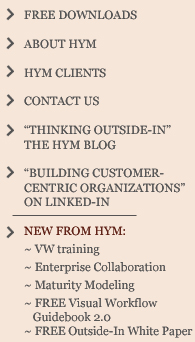

ENTERPRISE COLLABORATION
![]() Among the three elements that together constitute what we term “workflow,” we’ve had ample tools to for redesigning and managing two, workflow itself (how work objects move through process) and data flow. But the third, communication flow, has been much harder to manage – in part due in part to reliance on e-mail as a core messaging channel but also due to the severe limitations of the Outlook (and similar desktop) task manager.
Among the three elements that together constitute what we term “workflow,” we’ve had ample tools to for redesigning and managing two, workflow itself (how work objects move through process) and data flow. But the third, communication flow, has been much harder to manage – in part due in part to reliance on e-mail as a core messaging channel but also due to the severe limitations of the Outlook (and similar desktop) task manager.
Enterprise Collaboration, which combines communication process design with a new genre of enabling technology) resolves these issues. EC provides an IP-based communication/task management channel free of Outlook’s clutter and limitations. EC also provides a host of other value-creating collaborative capabilities:
Core EC Functionality |
| VoIP “push” messaging to bypass e-mail and voice mail |
| Task assignment and tracking |
| Alerts and escalations for actions not taken within specified times |
| Tracking personnel status and location, whether inside or outside the office |
| Expert routing to find alternative resources when primaries are unavailable |
| “Process presence,” indicating availability for a work assignment |
| Queuing and routing for prioritization and distribution of work |
| Consolidating all communication modes into a single log (UC) |
| VoIP location independence to tie in employees and customers |
| Real-time monitoring for visibility into work-in-process |
| Multi-dimensional reporting for identifying causes of delayed work |
![]() Perhaps best of all, the process element of EC happens within the broader context of Visual Workflow, no need to add an additional design step. And as a utility, the technology element is very unobtrusive and integrates readily with application software and legacy systems so users aren’t introducing another “application” to the often, overcrowded mix.
Perhaps best of all, the process element of EC happens within the broader context of Visual Workflow, no need to add an additional design step. And as a utility, the technology element is very unobtrusive and integrates readily with application software and legacy systems so users aren’t introducing another “application” to the often, overcrowded mix.
![]() Learn more: Introducing Enterprise-Wide Collaboration (EC) (PowerPoint presentation)
Learn more: Introducing Enterprise-Wide Collaboration (EC) (PowerPoint presentation)
©Copyright 2004-2010 High-Yield Methods - All Right Reserved
|
|
